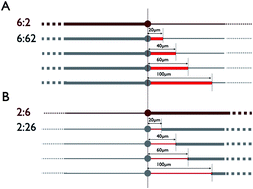Tuning the adhesive geometry of neurons: length and polarity control†
Abstract
Neurons acquire their functional and morphological axo-dendritic polarity by extending, from competing minor processes (neurites), one long axon among numerous dendrites. We employed complementary sets of micropatterns built from 2 and 6 μm wide stripes of various lengths to constrain hippocampal neuron shapes. Using these geometries, we have (i) limited the number of neuronal extensions to obtain a minimal in vitro system of bipolar neurons and (ii) controlled the neurite width during growth by the generation of a progressive cell shape asymmetry on either side of the cellular body. From this geometrical approach, we gained a high level of control of each neurite length and of the localization of axonal specification. To analyze these results, we developed a model based on a width and polarization dependent neurite elongation rate and on the existence of a critical neurite length that sets the axonal fate. Our data on the four series of micro-patterns developed for this study are described by a single set of growth parameters, well supported by experiments. The control of neuronal shapes by adhesive micro-patterns thereby offers a novel paradigm to follow the dynamical process of neurite lengthening and competition through the process of axonal polarization.

- This article is part of the themed collection: Proteins, cells, and tissues in patterned environments

 Please wait while we load your content...
Please wait while we load your content...